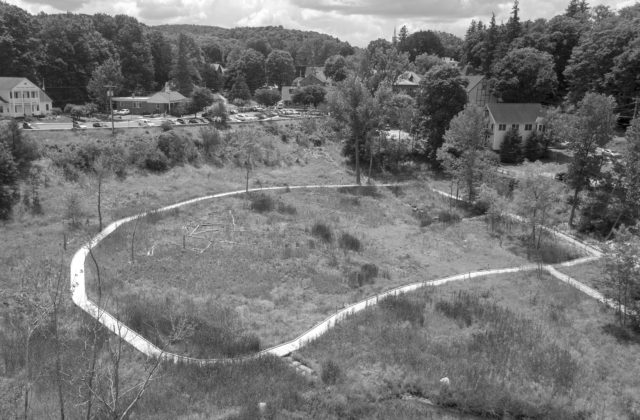City Meadow Park: Mire to Marsh
Connecting the village center with improved access and amenities
By David Beers
Photo by Christopher Little
The town’s storm water runoff takes a circuitous route through the soils and vegetation of City Meadow Park, which allows the water to be filtered of sediment and contaminants. In a very similar meandering fashion, the process of creating the park has been filtered by the many permit problems, funding hurdles, timeline setbacks, cost changes and plan revisions to create the clean green gem that is in the center of our town today.
Today’s current showcase of native wetland plants, with a boardwalk winding above, has come a long way from the muddy construction of late 2017. The meadow is now all green, the soils are stabilized, and the engineered drainage pattern is doing its job to clean storm water. Two years ago, the meadow was a field of invasive exotic phragmites reed and now most of that is replaced by native wetland vegetation (grasses, reeds, rushes, cattails, ferns, and shrubs). There is a small pond where the town can remove any sediment that drops out of the storm water and a large pond full of loud frogs and darting dragonflies.
A $500,000 Connecticut Main Street Grant was supplemented by $250,000 in private donations to get to this point. This means that no town taxpayer funds have been used for this project. Committee member Pete Anderson explains, “It says something pretty wonderful about our little village that the donations of almost a hundred generous Norfolkians make our work possible.” There is still more work to be done on this project, all of which will be funded by private donations and grants that the committee is now seeking.
The first step is to improve park access. Currently, the boardwalk is accessed from two locations. One is a new gravel parking lot next to the fire station on Shepard Road, and the other from a small town park on Greenwoods Road next to the former Haystack Pizza. But what City Meadow really needs is to create a simple link to the center of downtown that will attract many people into the park. Toward this end, the committee has drawn up plans to create a stairway from Robertson Plaza to the boardwalk. The stairway will have a deck entrance and multiple landings, for a safe 30’ vertical descent into the meadow. This stairway will go through the permit process this fall, and construction is planned for 2020.
Second is to improve park amenities. To better enjoy the large pond, an observation deck is currently going through the permit process and will be built in the fall. Three boardwalk bump-outs will also be constructed as part of the deck project. These bump-outs are like highway rest areas, with benches evenly spaced along the boardwalk. After this is all done, the committee would like to install some interpretive signs.
Lastly is vegetation maintenance. This includes periodically using a trimmer to keep the boardwalk free of vegetation and removing any hazardous dead trees and branches. Also, every other year selective brush cutting will occur in the dormant season to ensure that the meadow does not revert to unwanted trees and shrubs. Most importantly, the committee wants to ensure that the newly-established native wetland vegetation does not revert to the many exotic invasive plants that existed on this site before (phragmites reeds, honeysuckle shrubs, buckthorn shrubs, Norway maple trees.) While the majority of these invasives are gone, there are still a few stragglers that need to be purged – particularly phragmites reed.
As part of the Army Corp of Engineers’ permit for this project, the committee has recently hired botanists to determine how much of the plantings have survived, what and where the invasives are, and to make recommendations for vegetation management going forward. Any plantings that did not survive will have to be replaced, at no charge, by the original contractor for this project. It is expected that some of the remaining phragmites reed will need to be cut, with a drop of herbicide applied to the freshly cut stem. Periodic vegetation evaluation and maintenance will be a part of ensuring a vibrant wet meadow for years to come.
City Meadow Committee Chair, Molly Ackerly, summed it up by saying, “The shared vision of all of us who have been involved has been to turn the phragmites-infested wasteland into an attractive water-meadow park that will help connect the disjointed parts of the town center”.

